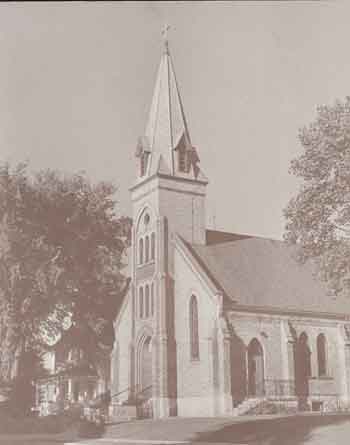 In 1889, a prairie Gothic edifice, pictured above, replaced the original church building of St. Jerome Parish, 211 S. Main St., Oconomowoc. This structure served the church until 2008 when on Nov. 15, former Milwaukee Archbishop Timothy M. Dolan dedicated the new church at 995 S. Lake St., Oconomowoc, its current location just a mile south of the historic site. (Submitted photo courtesy St. Jerome Parish, Oconomowoc, archives)Compiled by Tracy Rusch, using resources provided by parish secretary Jennie Frazer, and Fr. John Yockey, pastor.
In 1889, a prairie Gothic edifice, pictured above, replaced the original church building of St. Jerome Parish, 211 S. Main St., Oconomowoc. This structure served the church until 2008 when on Nov. 15, former Milwaukee Archbishop Timothy M. Dolan dedicated the new church at 995 S. Lake St., Oconomowoc, its current location just a mile south of the historic site. (Submitted photo courtesy St. Jerome Parish, Oconomowoc, archives)Compiled by Tracy Rusch, using resources provided by parish secretary Jennie Frazer, and Fr. John Yockey, pastor.
First church: Traveling priests and missionaries, like Fr. Martin Kundig in 1842, visited the Oconomowoc area when a small number of Catholics settled there. It is believed that first services were held in a private home as early as 1844, and tradition has it that Fr. Morrissey from Watertown said the first Mass. Fr. Hobbs, pastor of St. Catherine Parish, Mapleton, which was established in 1847, was the first pastor to visit Oconomowoc as a mission and held services in private dwellings until St. Jerome was founded as a mission of St. Catherine, Mapleton, in 1860, and dedicated in 1861. The red-framed structure cost about $1,500, and faced north toward the Milwaukee Road depot, built on land donated by Episcopalian John S. Rockwell, a prominent resident of the village of Oconomowoc. The mission was comprised of about 40 families. In 1870, a rectory was built and St. Jerome became a canonical parish. The original church was enlarged and served the community until 1889 when a prairie Gothic edifice was built on the property at 211 S. Main St., where it remained in use until 2008.
Current church: The 2007 groundbreaking for the new church on South Silver Lake Street completed the parish’s 10-year goal, “Building Foundations for Our Future,” which began after the community decided, through mailed ballots, to move a mile south of the historic site. Former Milwaukee Archbishop Timothy M. Dolan dedicated the new church Nov. 15, 2008, which cost $14 million. During the 10 years, the parish purchased 33 acres of usable land, conducted its first major capital campaign, built the school-education center, conducted a second capital campaign, then planned and built the current church – the third in St. Jerome’s history. The parish is now home to about 1,300 families.
First pastor: Fr. Hobbs was the first pastor (in residence at St. Catherine Parish, Mapleton), serving from 1847-1865. Fr. Allen, third pastor of the parish, was the first resident pastor.
Current pastor: Fr. John Yockey, since 1997; associate pastor Fr. Erich Weiss, since June 2010.
School: For 71 years, the School Sisters of Notre Dame served at St. Jerome Parish School, now in its 83rd year of operation. After the parish purchased land on the west side of Main Street, across from the church at 211 S. Main St., a day school opened Sept. 6, 1927, with about 120 pupils in its eight grades and four School Sisters of Notre Dame who came from the closed St. Mary’s School in Milwaukee. Before 1955, the auditorium and church basement housed temporary classrooms. Additions made in the 50s and 60s, added classrooms, offices, a nurse’s room, kitchen and more. The school was comprised of seven sisters, four lay teachers and 460 students in 1960, and reached peak enrollment of 568 students in 1969, which led to the introduction of tuition. The old school building was demolished in 2004 and replaced with the Berkshire Apartments for seniors on fixed income. That year, the Catholic community of St. Jerome dedicated its new school, 1001 S. Silver Lake St., on farm property purchased from Joe and Mary Watzl, officially completing phase one of the move to a new parish home on South Silver Lake Street. The school-education center, which cost $8,700,000, was dedicated Sept. 11, 2004.
Worth noting: The motto, “Building Foundations for Our Future,” has guided the Catholic community of St. Jerome through the whole process of purchasing 33 acres of usable land ($700,000), site preparation for construction ($1 million), conducting the capital campaigns and building the school-education center first, then the church. Fr. Yockey said the journey to date “has been nothing short of a miracle in the strict sense of that word.” He is confident that with “God’s continued blessing” the debt will be paid off by 2018. The 1889 church and 1906 rectory have yet to be sold. Church records state that for the first 50 years, St. Jerome parishioners were mostly Irish-born or of Irish descent. In 1960, St. Jerome Parish had about 700 families and celebrated six Masses each Sunday with assistance from Redemptorist Fathers who regularly helped there for more than 30 years and still do upon request.
